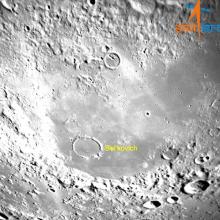Listen to today's episode of StarDate on the web the same day it airs in high-quality streaming audio without any extra ads or announcements. Choose a $8 one-month pass, or listen every day for a year for just $30.
You are here
Moon and Planets
The first people to drive on the Moon took their first jaunt 50 years ago this week. They weren’t actually on the Moon, though. Instead, they were driving from a control room in Russia.
Lunokhod 1 landed on November 16th, 1970, on a volcanic plain known as Mare Imbrium.
The rover looked like a bathtub with a lid on top. The lid opened during the day to expose its solar panels to the Sun. It closed at night to keep the rover warm.
Computer technology being what it was, the rover couldn’t drive itself. So using TV pictures, technicians drove it from Earth: a commander, driver, navigator, engineer, and antenna operator. It took more than four seconds from the time they gave a command until they could see Lunokhod respond. But during almost 11 months of operation, they drove it more than six miles.
The rover carried a device to reflect laser beams shot from Earth. Shortly after the rover expired, though, Earth lost it. It wasn’t found again until 2010, when it showed up in a picture snapped by a Moon-orbiting satellite. Scientists have used the reflector many times since then. Combined with other reflectors, it helps plot the distance to the Moon with an accuracy of less than a millimeter.
You don’t need that kind of accuracy to find the Moon this evening, though. It’s in the southwest at nightfall. Jupiter and Saturn line up to its upper left. Jupiter is closer to the Moon, and it’s by far the brighter of the two planets.
Script by Damond Benningfield





